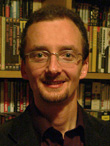Nino Rota: Music, Film and Feeling
Nino Rota: Music, Film and Feeling by Richard Dyer, (Palgrave Macmillan/BFI, 2010), 256 pages ISBN: 978-1844572106 (paperback), Price: £14.99
 About the reviewer: Dr Alex Marlow-Mann was previously Lecturer in European Film at the University of Birmingham and Acting Director of B-Film: The Birmingham Centre for Film Studies. He is a specialist on European (and particularly Italian) cinema with strong interests in regional cinemas, the politics of popular genre cinema, cognitive theory, film and emotion, and film preservation. He is the author of The New Neapolitan Cinema (EUP, 2011) and editor of Archival Film Festivals (St Andrews Film Studies, 2013). He is also one of the founding members of the British Association for Film, Television and Screen Studies (BAFTSS).
About the reviewer: Dr Alex Marlow-Mann was previously Lecturer in European Film at the University of Birmingham and Acting Director of B-Film: The Birmingham Centre for Film Studies. He is a specialist on European (and particularly Italian) cinema with strong interests in regional cinemas, the politics of popular genre cinema, cognitive theory, film and emotion, and film preservation. He is the author of The New Neapolitan Cinema (EUP, 2011) and editor of Archival Film Festivals (St Andrews Film Studies, 2013). He is also one of the founding members of the British Association for Film, Television and Screen Studies (BAFTSS).
A musical prodigy, Nino Rota was classically trained at the national conservatory in Rome and spent forty years teaching at the Bari Conservatory while simultaneously composing concerts, operas, symphonies, ballets and popular songs. However, his most significant legacy remains the scores he wrote for over 150 films, predominantly, though not exclusively, Italian in origin. Today Rota is remembered and loved above all for his soundtracks to Francis Ford Coppola’s hugely successful The Godfather (1972), The Godfather: Part II (1974) and for all fifteen of Federico Fellini’s single-authored features until Rota’s death in 1979.
At first glance a book on Nino Rota might seem like a surprising departure for Richard Dyer, best known for his pioneering work on stars, queer cinema and popular cinema and representation. While the book exemplifies two of the less familiar of Dyer’s many interests – Italian cinema and film music – in style and approach it is entirely consistent with his previous work. Moreover, it also touches on subjects that have occupied him in the past, including sexuality (Dyer speculates in passing that the never-married Rota was either asexual or a celibate homosexual) and pastiche, the subject of his last book, Pastiche (2006, Routledge).
The book begins by addressing the accusation that Rota was a self-plagiarist (he was disqualified for an Oscar for the The Godfather because the main theme reworked music he composed in 1958 for Fortunella, only to win for the sequel – the Academy ironically being unaware that it, too, drew inspiration from earlier scores). Dyer argues that imitation in the form of both (self-) plagiarism and pastiche constitutes one of the hallmarks of Rota’s style and makes a convincing case for the artistic value of this controversial strategy. After a brief biographical sketch Dyer then sets out to identify the unique quality of Rota’s aesthetic, which he defines as ‘ironic attachment’, a state of being ‘close, very close, to the world of the film, but not at one with it, neither a part nor apart.’ The explanation of this aesthetic emerges organically from detailed textual analysis of Rota’s scores, and Dyer achieves this magnificently.
… an exemplary piece of scholarship
Recognising that the book is aimed primarily at Anglophone film scholars, Dyer largely eschews the language of musicology and is always careful to situate his discussions of Italian films within their broader narrative and historical context. The book is particularly good at showing how music functions in films, paying close attention to the specific formal qualities of both media without ever getting bogged down by jargon or theory. The breadth of Dyer’s knowledge is never less than impressive and scholars of Italian cinema will find a wealth of useful and consistently apposite observations and arguments relating to a host of well- and lesser-known films and filmmakers. The book concludes, as it probably should, with a chapter dedicated to Rota’s work for Fellini, clarifying exactly why theirs was such a natural synergy and offering valuable new insights for Fellini scholarship.
Nino Rota: Music, Film and Feeling is an exemplary piece of scholarship which contributes greatly to our knowledge in several fields and expertly elucidates an art form that does not lend itself easily to verbal description.
Dr Alex Marlow-Mann
 Learning on Screen
Learning on Screen